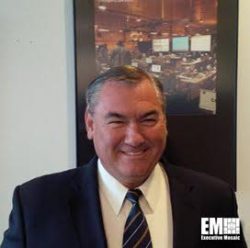“I don’t think of difficulties; I think of welcome challenges.”

EM: Let’s start with your background and how you get to where you are today. Your title is Executive VP of Joint Unmanned Systems and Training Solutions for AECOM.
Tim Saffold: I am pleased and feel privileged to be working on the AECOM team with the ability to work across the entire company specifically on unmanned systems. After a successful 31-year career in the Air Force, retiring as a senior officer, I was given the opportunity to go to work for what was then URS. My background as a leader, pilot, strategist, and technical expert in several areas led URS to hire me to create the strategy and lead the company’s expansion into unmanned systems. While the company already had some experience in this area, it was looking for a broader portfolio and a way to increase that portfolio with sustained growth. Early government sector success in unmanned systems led to expanded responsibility for me in the simulation and training market sector; and then this was followed by an expansion of unmanned systems responsibility in the commercial sector. Working now on the AECOM team, I lead efforts across both government and commercial sectors. This includes defense, the Department of Energy and also commercial operations. Commercially, we operate across multiple sectors that include energy, oil and gas, construction, and environment. AECOM has given me opportunities to increase my responsibilities and expand the company’s portfolio in all of these different areas.
EM: What is the hardest aspect of program management?
Tim Saffold: I don’t think of difficulties; I think of welcome challenges. You can imagine that in this industry the technical requirements are very exacting and demanding. That means that technical solutions need to be precise and need to be capable of accomplishing the many different tasks that commercial and government clients require. Doing this demands that I fully understand the technical capabilities that exist in both commercial and government sectors and also communicate these capabilities across AECOM in ways that are open, transparent, factual, and to-the-point. You have to be able to speak the language of the government and the commercial language as well and understand the long and the short-term strategies that will enable success in all these different areas.
EM: What does the future of joined unmanned systems look like in the federal sector?
Tim Saffold: In the federal sector, unmanned systems are here to stay. We have developed a very strong and capable portfolio of services that we offer a number of different clients. We provide those services under exacting standards and have done so exceptionally well for many years. With that background, experience and our ability to continually improve our AECOM capability (and the fact that we are in 150 countries around the world and our footprint is significant in terms of employee size and locations) we have the opportunity to service clients globally in a number of different market sectors.
EM: What is a crucial lesson you learned along the way from Air Force to where you are now, in working with other clients in program management?
Tim Saffold:Â Clear communications and transparency are absolutely essential to creating understanding about what this technical capability can do for anyone. The ability to do this is essential in this particular discipline for not only me but for the many others who do this type of work as well. Once you combine the technical expertise with the ability to communicate at multiple levels to different audiences, you can find success while mitigating a number of challenges that might come from the various projects you are engaged in.
EM: Do you have anything else to add?
Tim Saffold: Unmanned systems are essential in the commercial marketplace. However, systems employment has to be approached from a disciplined perspective to ensure that you get legally compliant, safe and efficient operations. This is the path that AECOM has chosen to follow – making sure that unmanned systems are a professional capability within our company’s ‘Design, Build, Finance, and Operate‘ (DBFO) construct. The expansion of technical capability through miniaturization of key technologies such as LiDAR, thermal imaging, along with great improvements in photogrammetry are creating exciting, cost-efficient ways for clients to obtain critical data–critical data that clients can then turn into decision-quality information. It’s really all about the data and quality of that data to support decisions. As government agencies continue to align regulatory policy with the rapid pace of technical advancement, you now have a marketplace that is increasing demand for this useful technology that solves a lot of difficult data collection problems. These problems are often called dull, dirty, and/or dangerous and we’re working to employ capability that solves that. This is an important aspect of my portfolio within AECOM as we continue to expand our capability in the commercial sector.




